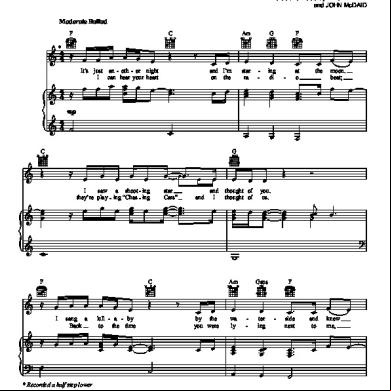Pseudo-nmos.pdf 3z6c3t
This document was ed by and they confirmed that they have the permission to share it. If you are author or own the copyright of this book, please report to us by using this report form. Report 3i3n4
Overview 26281t
& View Pseudo-nmos.pdf as PDF for free.
More details 6y5l6z
- Words: 1,922
- Pages: 22
Pseudo nMOS Design Style
Logic Design Styles Dinesh Sharma Microelectronics Group, EE Department IIT Bombay, Mumbai
July 26, 2016
Dinesh Sharma
Logic Design Styles
Pseudo nMOS Design Style
Static Characteristics Noise margins Dynamic characteristics Pseudo nMOS design Flow
CMOS summary Logic consumes no static power in CMOS design style. Vdd
Vi
Vo
However, signals have to be routed to the n pull down network as well as to the p pull up network. So the load presented to every driver is high. This is exacerbated by the fact that n and p channel transistors cannot be placed close together as these are in different wells which have to be kept well separated in order to avoid latchup. Dinesh Sharma
Logic Design Styles
Pseudo nMOS Design Style
Static Characteristics Noise margins Dynamic characteristics Pseudo nMOS design Flow
Pseudo nMOS Design Style
Vdd Out in Gnd
The CMOS pull up network is replaced by a single pMOS transistor with its gate grounded. Since the pMOS is not driven by signals, it is always ‘on’. The effective gate voltage seen by the pMOS transistor is Vdd . Thus the over-voltage on the p channel gate is always Vdd - VTp . When the nMOS is turned ‘on’, a direct path between supply and ground exists and static power will be drawn. However, the dynamic power is reduced capacitive loading Dineshdue Sharmato lower Logic Design Styles
Pseudo nMOS Design Style
Static Characteristics Noise margins Dynamic characteristics Pseudo nMOS design Flow
Static Characteristics
As we sweep the input voltage from ground to Vdd , we encounter the following regimes of operation: nMOS ‘off’ nMOS saturated, pMOS linear nMOS linear, pMOS linear nMOS linear, pMOS saturated
Dinesh Sharma
Logic Design Styles
Pseudo nMOS Design Style
Static Characteristics Noise margins Dynamic characteristics Pseudo nMOS design Flow
Low input
Vdd Out in
When the input voltage is less than VTn . The output is ‘high’ and no current is drawn from the supply. As we raise the input just above VTn , the output starts falling.
Gnd
In this region the nMOS is saturated, while the pMOS is linear
Dinesh Sharma
Logic Design Styles
Pseudo nMOS Design Style
Static Characteristics Noise margins Dynamic characteristics Pseudo nMOS design Flow
nMOS saturated, pMOS linear The input voltage is assumed to be sufficiently low so that the output voltage exceeds the saturation voltage Vi − VTn . Normally, this voltage will be higher than VTp , so the p channel transistor is in linear mode of operation. Equating currents through the n and p channel transistors, we get Kn 1 2 (Vi − VTn )2 Kp (Vdd − VTp )(Vdd − Vo ) − (Vdd − Vo ) = 2 2 defining V1 ≡ Vdd − Vo and V2 ≡ Vdd − VTp , we get 1 2 β V1 − V2 V1 + (Vi − VTn )2 = 0 2 2 Dinesh Sharma
Logic Design Styles
Pseudo nMOS Design Style
Static Characteristics Noise margins Dynamic characteristics Pseudo nMOS design Flow
nMOS saturated, pMOS linear β 1 2 V1 − V2 V1 + (Vi − VTn )2 = 0 2 2 The solutions are: q V1 = V2 ± V22 − β(Vi − VTn )2
substituting the values of V1 and V2 and choosing the sign which puts Vo in the correct range, we get q Vo = VTp + (Vdd − VTp )2 − β(Vi − VTn )2 Dinesh Sharma
Logic Design Styles
Pseudo nMOS Design Style
Static Characteristics Noise margins Dynamic characteristics Pseudo nMOS design Flow
nMOS linear, pMOS linear Vo = VTp +
q
(Vdd − VTp )2 − β(Vi − VTn )2
As the input voltage is increased, the output voltage will decrease. The output voltage will fall below Vi − VTn when q 2 + (β + 1)V (V VTp + VTp dd dd − 2VTp ) Vi > VTn + β+1 The nMOS is now in its linear mode of operation. The derived equation does not apply beyond this input voltage. Dinesh Sharma
Logic Design Styles
Pseudo nMOS Design Style
Static Characteristics Noise margins Dynamic characteristics Pseudo nMOS design Flow
nMOS linear, pMOS saturated As the input voltage is raised still further, the output voltage will fall below VTp . The pMOS transistor is now in saturation regime. Equating currents, we get Kp 1 2 (Vdd − VTp )2 Kn (Vi − VTn )Vo − Vo = 2 2 which gives (Vdd − VTp )2 1 2 Vo − (Vo − VTn )Vo + 2 2β This can be solved to get Vo = (Vi − VTn ) −
q
(Vi − VTn )2 − (Vdd − VTp )2 /β
Dinesh Sharma
Logic Design Styles
Pseudo nMOS Design Style
Static Characteristics Noise margins Dynamic characteristics Pseudo nMOS design Flow
Noise Margins We find points on the transfer curve where the slope is -1. When the input is low and output high, we should use q Vo = VTp + (Vdd − VTp )2 − β(Vi − VTn )2
Differentiating this equation with respect to Vi and setting the slope to -1, we get
and
Vdd − VTp ViL = VTn + p β(β + 1) VoH = VTp +
s
Dinesh Sharma
β (V − VTp ) β + 1 dd Logic Design Styles
Pseudo nMOS Design Style
Static Characteristics Noise margins Dynamic characteristics Pseudo nMOS design Flow
When the input is high and the output low, we use q Vo = (Vi − VTn ) − (Vi − VTn )2 − (Vdd − VTp )2 /β
Differentiating with respect to Vi and setting the slope to -1, we get 2 (Vdd − VTp ) ViH = VTn + √ 3β and VoL =
(Vdd − VTp ) √ 3β
Dinesh Sharma
Logic Design Styles
Pseudo nMOS Design Style
Static Characteristics Noise margins Dynamic characteristics Pseudo nMOS design Flow
Ratioed Logic To make the output ‘low’ value lower than VTn , we get the condition 1 Vdd − VTp 2 β> 3 VTn This places a requirement on the ratios of widths of n and p channel transistors. The logic gates work properly only when this equation is satisfied. Therefore this kind of logic is also called ‘ratioed logic’. In contrast, CMOS logic is called ratioless logic because it does not place any restriction on the ratios of widths of n and p channel transistors for static operation. The noise margin for pseudo nMOS can be determined easily from the expressions for ViL , VoL , ViH , VoH . Dinesh Sharma
Logic Design Styles
Pseudo nMOS Design Style
Static Characteristics Noise margins Dynamic characteristics Pseudo nMOS design Flow
Rise Time
Vdd ViL Vo
When the input is low, the nMOS is off and the output rises from ‘low’ to ‘high’. The situation is identical to the charge up condition of a CMOS gate with the pMOS being biased with its gate at 0V.
This gives τrise
2VTp Vdd + VoH − 2VTp C + ln = Kp (Vdd − VTp ) Vdd − VTp Vdd − VoH Dinesh Sharma
Logic Design Styles
Pseudo nMOS Design Style
Static Characteristics Noise margins Dynamic characteristics Pseudo nMOS design Flow
Fall Time
Vdd Out
in Gnd
Calculation of fall time is complicated by the fact that the pMOS load continues to dump current in the output node, even as the nMOS tries to discharge the output capacitor. The nMOS needs to sink the discharge current as well as the drain current of the pMOS transistor. Simplifying assumption: pMOS current remains constant at its saturation value through the entire discharge process.
(This will result in a slightly pessimistic value of discharge time). Dinesh Sharma
Logic Design Styles
Static Characteristics Noise margins Dynamic characteristics Pseudo nMOS design Flow
Pseudo nMOS Design Style
Fall Time If we assume that the pMOS current remains constant at its saturation value, Kp Ip = (Vdd − VTp )2 2 . We can write the KCL equation at the output node as: In − Ip + C
dVo =0 dt
which gives τfall =− C
Z
VoL Vdd
dVo In − Ip
We define V1 ≡ Vi − VTn and V2 ≡ Vdd − VTp . Dinesh Sharma
Logic Design Styles
Pseudo nMOS Design Style
Static Characteristics Noise margins Dynamic characteristics Pseudo nMOS design Flow
Fall Time
Vdd Out
The integration range can be divided into two regimes. nMOS is saturated when V1 ≤ Vo < Vdd . It is in the linear regime when VoL < Vo < V1 .
in Gnd
Dinesh Sharma
Logic Design Styles
Static Characteristics Noise margins Dynamic characteristics Pseudo nMOS design Flow
Pseudo nMOS Design Style
Fall Time
τfall =− C
Z
V1
Vdd
dVo − 1 2 2 Kn V1 − Ip
Z
VoL
V1
dVo Kn (V1 Vo − 21 Vo2 ) − Ip
so, τfall V − V1 = 1 dd 2 + C 2 Kn V1 − Ip
Z
Dinesh Sharma
V1 VoL
dVo Kn (V1 Vo − 21 Vo2 ) − Ip
Logic Design Styles
Pseudo nMOS Design Style
Static Characteristics Noise margins Dynamic characteristics Pseudo nMOS design Flow
Pseudo nMOS Inverter design
We design the basic inverter and then scale device sizes based on the logic function being designed. The load device size is calculated from the rise time. 2VTp Vdd + VoH − 2VTp C + ln τrise = Kp (Vdd − VTp ) Vdd − VTp Vdd − VoH Given a value of τrise , operating voltages and technological constants, Kp and hence, the geometry of the p channel transistor can be determined.
Dinesh Sharma
Logic Design Styles
Pseudo nMOS Design Style
Static Characteristics Noise margins Dynamic characteristics Pseudo nMOS design Flow
Pseudo nMOS Inverter design
Geometry of the n channel transistor can be determined from static considerations. q VoL = (ViH − VTn ) − (ViH − VTn )2 − (Vdd − VTp )2 /β We take VoL = VTn , and calculate β.
But β ≡ Kn /Kp and Kp is already known.
This evaluates Kn and hence, the geometry of the n channel transistor.
Dinesh Sharma
Logic Design Styles
Pseudo nMOS Design Style
Static Characteristics Noise margins Dynamic characteristics Pseudo nMOS design Flow
Conversion to other logic
Once the basic pseudo nMOS inverter is designed, other logic gates can be derived from it. The procedure is the same as that for CMOS, except that it is applied only to nMOS transistors. The p channel transistor is kept at the same size as that for an inverter.
Dinesh Sharma
Logic Design Styles
Pseudo nMOS Design Style
Static Characteristics Noise margins Dynamic characteristics Pseudo nMOS design Flow
Conversion to other logic
The logic is expressed as a sum of products with a bar (inversion) on top. For every ‘.’ in the expression, we put the corresponding n channel transistors in series. For every ‘+’, we put the n channel transistors in parallel. We scale the transistor widths up by the number of devices put in series. The geometries are left untouched for devices put in parallel.
Dinesh Sharma
Logic Design Styles
Pseudo nMOS Design Style
Static Characteristics Noise margins Dynamic characteristics Pseudo nMOS design Flow
A.B + C.(D + E) in pseudo-nMOS
Vdd Out
A
B
C
D
E
A and B are in series. The pair is in parallel with C which is in series with a parallel combination of D and E.
Implementation of A.B + C.(D + E ) in pseudo-nMOS logic design style.
Dinesh Sharma
Logic Design Styles
Logic Design Styles Dinesh Sharma Microelectronics Group, EE Department IIT Bombay, Mumbai
July 26, 2016
Dinesh Sharma
Logic Design Styles
Pseudo nMOS Design Style
Static Characteristics Noise margins Dynamic characteristics Pseudo nMOS design Flow
CMOS summary Logic consumes no static power in CMOS design style. Vdd
Vi
Vo
However, signals have to be routed to the n pull down network as well as to the p pull up network. So the load presented to every driver is high. This is exacerbated by the fact that n and p channel transistors cannot be placed close together as these are in different wells which have to be kept well separated in order to avoid latchup. Dinesh Sharma
Logic Design Styles
Pseudo nMOS Design Style
Static Characteristics Noise margins Dynamic characteristics Pseudo nMOS design Flow
Pseudo nMOS Design Style
Vdd Out in Gnd
The CMOS pull up network is replaced by a single pMOS transistor with its gate grounded. Since the pMOS is not driven by signals, it is always ‘on’. The effective gate voltage seen by the pMOS transistor is Vdd . Thus the over-voltage on the p channel gate is always Vdd - VTp . When the nMOS is turned ‘on’, a direct path between supply and ground exists and static power will be drawn. However, the dynamic power is reduced capacitive loading Dineshdue Sharmato lower Logic Design Styles
Pseudo nMOS Design Style
Static Characteristics Noise margins Dynamic characteristics Pseudo nMOS design Flow
Static Characteristics
As we sweep the input voltage from ground to Vdd , we encounter the following regimes of operation: nMOS ‘off’ nMOS saturated, pMOS linear nMOS linear, pMOS linear nMOS linear, pMOS saturated
Dinesh Sharma
Logic Design Styles
Pseudo nMOS Design Style
Static Characteristics Noise margins Dynamic characteristics Pseudo nMOS design Flow
Low input
Vdd Out in
When the input voltage is less than VTn . The output is ‘high’ and no current is drawn from the supply. As we raise the input just above VTn , the output starts falling.
Gnd
In this region the nMOS is saturated, while the pMOS is linear
Dinesh Sharma
Logic Design Styles
Pseudo nMOS Design Style
Static Characteristics Noise margins Dynamic characteristics Pseudo nMOS design Flow
nMOS saturated, pMOS linear The input voltage is assumed to be sufficiently low so that the output voltage exceeds the saturation voltage Vi − VTn . Normally, this voltage will be higher than VTp , so the p channel transistor is in linear mode of operation. Equating currents through the n and p channel transistors, we get Kn 1 2 (Vi − VTn )2 Kp (Vdd − VTp )(Vdd − Vo ) − (Vdd − Vo ) = 2 2 defining V1 ≡ Vdd − Vo and V2 ≡ Vdd − VTp , we get 1 2 β V1 − V2 V1 + (Vi − VTn )2 = 0 2 2 Dinesh Sharma
Logic Design Styles
Pseudo nMOS Design Style
Static Characteristics Noise margins Dynamic characteristics Pseudo nMOS design Flow
nMOS saturated, pMOS linear β 1 2 V1 − V2 V1 + (Vi − VTn )2 = 0 2 2 The solutions are: q V1 = V2 ± V22 − β(Vi − VTn )2
substituting the values of V1 and V2 and choosing the sign which puts Vo in the correct range, we get q Vo = VTp + (Vdd − VTp )2 − β(Vi − VTn )2 Dinesh Sharma
Logic Design Styles
Pseudo nMOS Design Style
Static Characteristics Noise margins Dynamic characteristics Pseudo nMOS design Flow
nMOS linear, pMOS linear Vo = VTp +
q
(Vdd − VTp )2 − β(Vi − VTn )2
As the input voltage is increased, the output voltage will decrease. The output voltage will fall below Vi − VTn when q 2 + (β + 1)V (V VTp + VTp dd dd − 2VTp ) Vi > VTn + β+1 The nMOS is now in its linear mode of operation. The derived equation does not apply beyond this input voltage. Dinesh Sharma
Logic Design Styles
Pseudo nMOS Design Style
Static Characteristics Noise margins Dynamic characteristics Pseudo nMOS design Flow
nMOS linear, pMOS saturated As the input voltage is raised still further, the output voltage will fall below VTp . The pMOS transistor is now in saturation regime. Equating currents, we get Kp 1 2 (Vdd − VTp )2 Kn (Vi − VTn )Vo − Vo = 2 2 which gives (Vdd − VTp )2 1 2 Vo − (Vo − VTn )Vo + 2 2β This can be solved to get Vo = (Vi − VTn ) −
q
(Vi − VTn )2 − (Vdd − VTp )2 /β
Dinesh Sharma
Logic Design Styles
Pseudo nMOS Design Style
Static Characteristics Noise margins Dynamic characteristics Pseudo nMOS design Flow
Noise Margins We find points on the transfer curve where the slope is -1. When the input is low and output high, we should use q Vo = VTp + (Vdd − VTp )2 − β(Vi − VTn )2
Differentiating this equation with respect to Vi and setting the slope to -1, we get
and
Vdd − VTp ViL = VTn + p β(β + 1) VoH = VTp +
s
Dinesh Sharma
β (V − VTp ) β + 1 dd Logic Design Styles
Pseudo nMOS Design Style
Static Characteristics Noise margins Dynamic characteristics Pseudo nMOS design Flow
When the input is high and the output low, we use q Vo = (Vi − VTn ) − (Vi − VTn )2 − (Vdd − VTp )2 /β
Differentiating with respect to Vi and setting the slope to -1, we get 2 (Vdd − VTp ) ViH = VTn + √ 3β and VoL =
(Vdd − VTp ) √ 3β
Dinesh Sharma
Logic Design Styles
Pseudo nMOS Design Style
Static Characteristics Noise margins Dynamic characteristics Pseudo nMOS design Flow
Ratioed Logic To make the output ‘low’ value lower than VTn , we get the condition 1 Vdd − VTp 2 β> 3 VTn This places a requirement on the ratios of widths of n and p channel transistors. The logic gates work properly only when this equation is satisfied. Therefore this kind of logic is also called ‘ratioed logic’. In contrast, CMOS logic is called ratioless logic because it does not place any restriction on the ratios of widths of n and p channel transistors for static operation. The noise margin for pseudo nMOS can be determined easily from the expressions for ViL , VoL , ViH , VoH . Dinesh Sharma
Logic Design Styles
Pseudo nMOS Design Style
Static Characteristics Noise margins Dynamic characteristics Pseudo nMOS design Flow
Rise Time
Vdd ViL Vo
When the input is low, the nMOS is off and the output rises from ‘low’ to ‘high’. The situation is identical to the charge up condition of a CMOS gate with the pMOS being biased with its gate at 0V.
This gives τrise
2VTp Vdd + VoH − 2VTp C + ln = Kp (Vdd − VTp ) Vdd − VTp Vdd − VoH Dinesh Sharma
Logic Design Styles
Pseudo nMOS Design Style
Static Characteristics Noise margins Dynamic characteristics Pseudo nMOS design Flow
Fall Time
Vdd Out
in Gnd
Calculation of fall time is complicated by the fact that the pMOS load continues to dump current in the output node, even as the nMOS tries to discharge the output capacitor. The nMOS needs to sink the discharge current as well as the drain current of the pMOS transistor. Simplifying assumption: pMOS current remains constant at its saturation value through the entire discharge process.
(This will result in a slightly pessimistic value of discharge time). Dinesh Sharma
Logic Design Styles
Static Characteristics Noise margins Dynamic characteristics Pseudo nMOS design Flow
Pseudo nMOS Design Style
Fall Time If we assume that the pMOS current remains constant at its saturation value, Kp Ip = (Vdd − VTp )2 2 . We can write the KCL equation at the output node as: In − Ip + C
dVo =0 dt
which gives τfall =− C
Z
VoL Vdd
dVo In − Ip
We define V1 ≡ Vi − VTn and V2 ≡ Vdd − VTp . Dinesh Sharma
Logic Design Styles
Pseudo nMOS Design Style
Static Characteristics Noise margins Dynamic characteristics Pseudo nMOS design Flow
Fall Time
Vdd Out
The integration range can be divided into two regimes. nMOS is saturated when V1 ≤ Vo < Vdd . It is in the linear regime when VoL < Vo < V1 .
in Gnd
Dinesh Sharma
Logic Design Styles
Static Characteristics Noise margins Dynamic characteristics Pseudo nMOS design Flow
Pseudo nMOS Design Style
Fall Time
τfall =− C
Z
V1
Vdd
dVo − 1 2 2 Kn V1 − Ip
Z
VoL
V1
dVo Kn (V1 Vo − 21 Vo2 ) − Ip
so, τfall V − V1 = 1 dd 2 + C 2 Kn V1 − Ip
Z
Dinesh Sharma
V1 VoL
dVo Kn (V1 Vo − 21 Vo2 ) − Ip
Logic Design Styles
Pseudo nMOS Design Style
Static Characteristics Noise margins Dynamic characteristics Pseudo nMOS design Flow
Pseudo nMOS Inverter design
We design the basic inverter and then scale device sizes based on the logic function being designed. The load device size is calculated from the rise time. 2VTp Vdd + VoH − 2VTp C + ln τrise = Kp (Vdd − VTp ) Vdd − VTp Vdd − VoH Given a value of τrise , operating voltages and technological constants, Kp and hence, the geometry of the p channel transistor can be determined.
Dinesh Sharma
Logic Design Styles
Pseudo nMOS Design Style
Static Characteristics Noise margins Dynamic characteristics Pseudo nMOS design Flow
Pseudo nMOS Inverter design
Geometry of the n channel transistor can be determined from static considerations. q VoL = (ViH − VTn ) − (ViH − VTn )2 − (Vdd − VTp )2 /β We take VoL = VTn , and calculate β.
But β ≡ Kn /Kp and Kp is already known.
This evaluates Kn and hence, the geometry of the n channel transistor.
Dinesh Sharma
Logic Design Styles
Pseudo nMOS Design Style
Static Characteristics Noise margins Dynamic characteristics Pseudo nMOS design Flow
Conversion to other logic
Once the basic pseudo nMOS inverter is designed, other logic gates can be derived from it. The procedure is the same as that for CMOS, except that it is applied only to nMOS transistors. The p channel transistor is kept at the same size as that for an inverter.
Dinesh Sharma
Logic Design Styles
Pseudo nMOS Design Style
Static Characteristics Noise margins Dynamic characteristics Pseudo nMOS design Flow
Conversion to other logic
The logic is expressed as a sum of products with a bar (inversion) on top. For every ‘.’ in the expression, we put the corresponding n channel transistors in series. For every ‘+’, we put the n channel transistors in parallel. We scale the transistor widths up by the number of devices put in series. The geometries are left untouched for devices put in parallel.
Dinesh Sharma
Logic Design Styles
Pseudo nMOS Design Style
Static Characteristics Noise margins Dynamic characteristics Pseudo nMOS design Flow
A.B + C.(D + E) in pseudo-nMOS
Vdd Out
A
B
C
D
E
A and B are in series. The pair is in parallel with C which is in series with a parallel combination of D and E.
Implementation of A.B + C.(D + E ) in pseudo-nMOS logic design style.
Dinesh Sharma
Logic Design Styles





